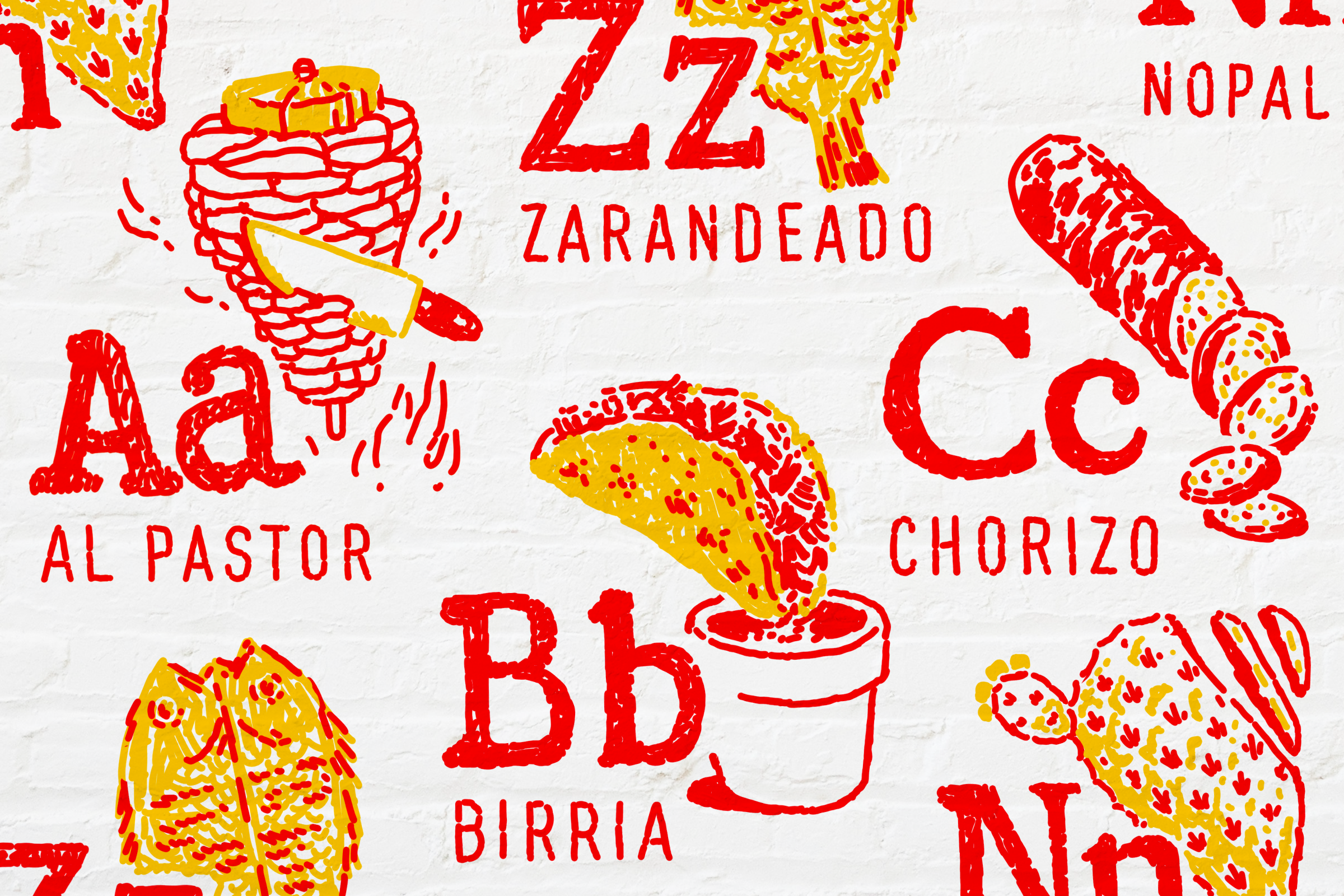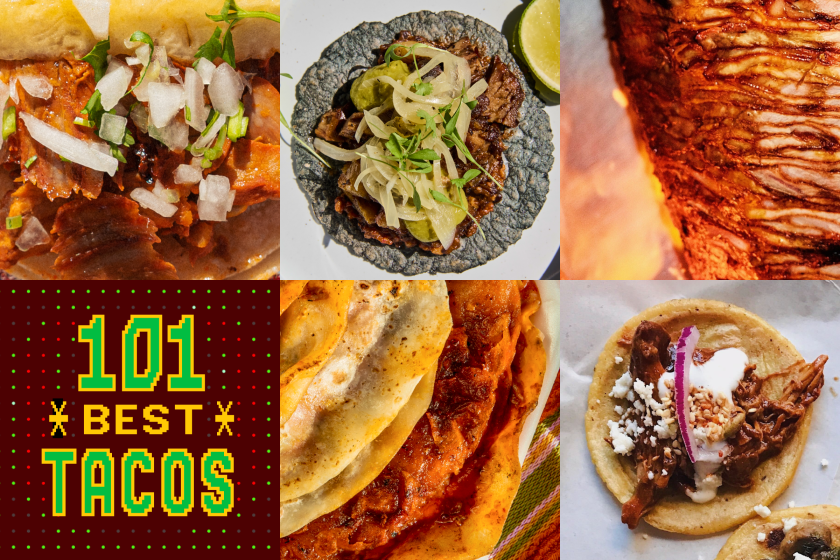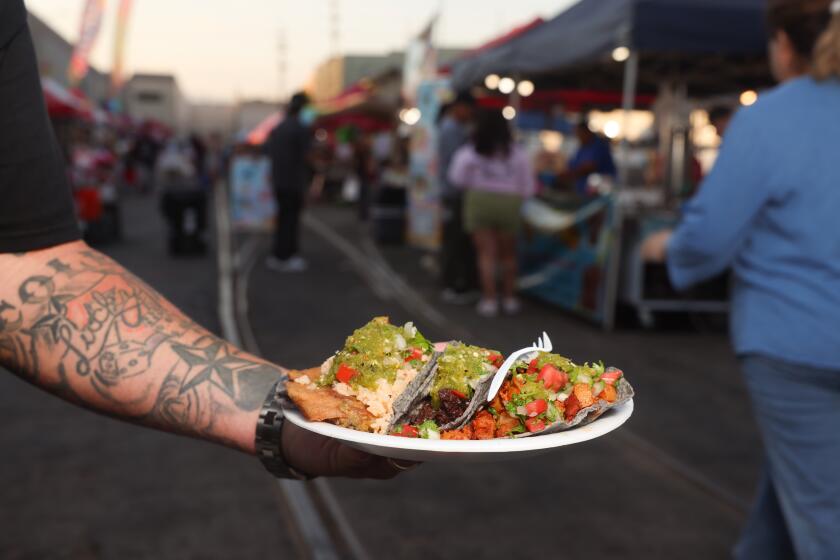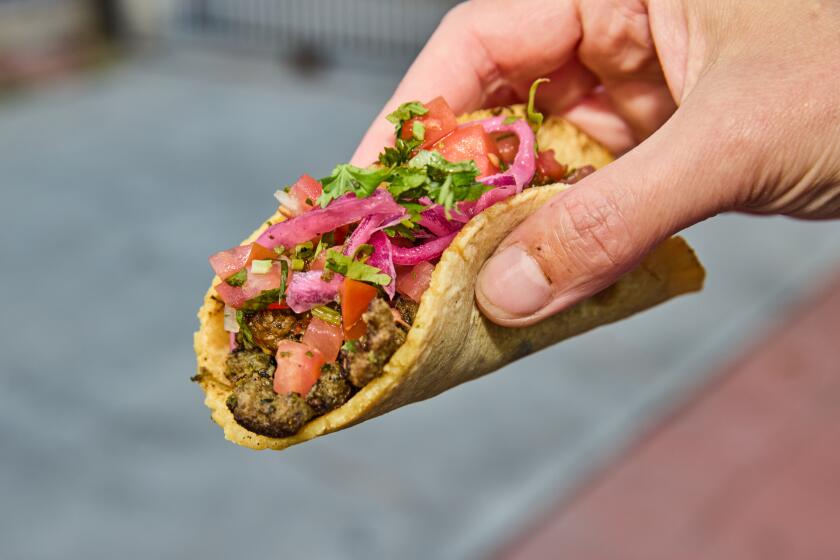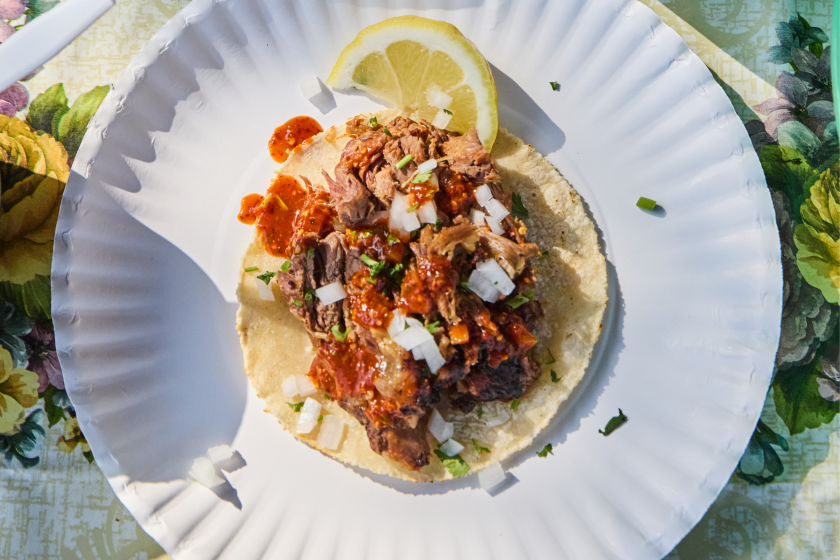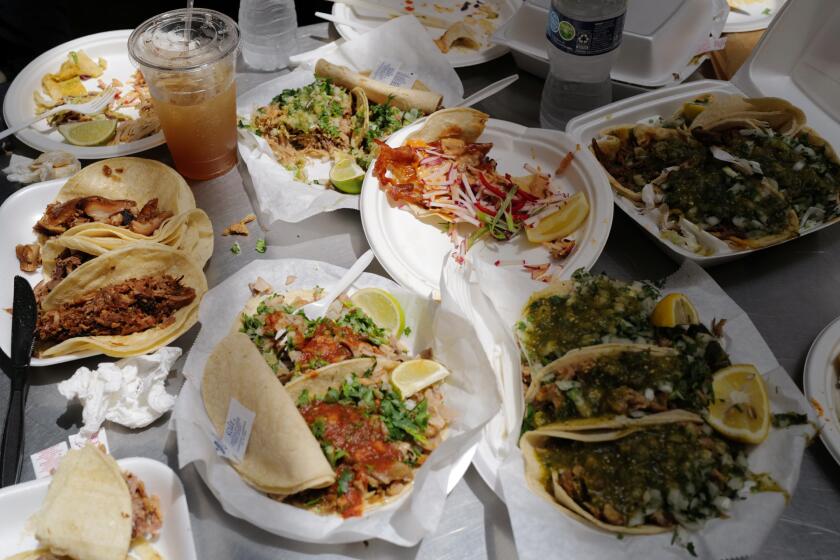
When ordering tacos in Los Angeles, it’s helpful to have some Spanish terms and phrases at the ready. Keep this glossary handy during taco crawls and you’ll soon be ordering like a pro.
Adobada: Term for al pastor in Tijuana. Meat — often pork — marinated in a red adobo sauce; roasted on a trompo or sometimes cooked on the plancha or grill.
Alambre: A dish of meats mixed and sauteed on a plancha with chopped bacon, cheese, bell peppers and onion, served in a pile topped with tortillas to make multiple tacos.
Al carbón: On mesquite or charcoal.
Al pastor: Pork shoulder extravagantly marinated with guajillo and achiote chiles and other spices, cut into long sheets, and stacked over a vertical spit called a trompo.
Get to know Los Angeles through the tacos that bring it to life. From restaurants to trucks to carts and more, here’s 101 of the city’s best.
Al vapor: Translates to “steamed tacos.” This type of taco is steamed until soft inside and out. The filling can be a mixture of pulled meat and smooth mashed potato.
Barbacoa: Slow-cooked, spice-rubbed meat such as whole cow, beef head, goat or sheep, traditionally roasted in maguey leaves in a pit in the ground.
Birria: Typically slow-cooked in a clay pot, birria can be made from goat, beef or lamb. The meat is prepared with an adobo rub made with different types of chiles — árbol, pasilla, ancho — and spices such as cumin, cloves and sesame, along with tomato, onions and garlic.
Buche: Pork stomach, also known commonly as hog maws. Like other offal meats, the texture softens and becomes more tender after cooking.
Cabeza: Meat derived from beef head, either roasted, steamed or braised.
Cachete: Meat from the beef cheek.
Camarón: Shrimp.
Carnitas: Shreds or bits of pork, literally “little meats,” typically from pork butt or shoulder but sometimes with pork belly or other cuts, braised or slow-simmered in lard preferably in a large copper cazo. If you want your carnitas meat to be fleshy chunk only, request them as “maciza.”
Cazo: A large, thick-bottomed cooking pot, often made of copper, traditionally used to simmer carnitas.
Cebollitas asadas: Grilled onions, served whole with green stems or simply bulbs, sometimes available along with salsas and limones to garnish.
Chivo: Goat.
Choricera: A steel frying pan with a raised center where various cuts of meat are cooked in their own juices.
Chorizo: Finely ground pork sausage highly seasoned with vinegar and usually red chile peppers. It can also be made with beef.
Choripapa: Chorizo with potatoes.
Chicharrón: Typically deep-fried pork belly or pork rind.
Chuleta: Pork chop, usually thinly sliced in taco form.
Cochinita pibil: A slow-roasted pork dish from the Yucatán Peninsula that involves marinating the meat of a baby pig in achiote and citrus juice. The meat is wrapped in a banana leaf before roasting.
Comal: A flat cooking apparatus primarily used to make fresh tortillas.
Consomé/consommé: A broth. Mexican Spanish is consomé; English usage is the latter.
Con todo: “With everything,” or “Everything on it.”
Costilla: Rib, refers to rib meat — either beef or pork.
Cueritos: Made of pork skin, cueritos are pickled in vinegar giving them a brininess. The translucent, short curls get their name from the Spanish word “cuero,” which translates to “leather” in English.
Guisados: A broad term, but usually refers to braises and stews.
Hongos: Mushrooms, also referred to as champiñones.
Huitlacoche: A darkened fungus that grows on corn; has an earthy taste, often compared to black truffles.
Limón/limones: Limes, ideally key limes or Mexican limes. Unripe Mexican limones are ideal for a final squeeze of acidity as a taco’s last garnish. Avoid yellow lemons, though many taquerias serve these as substitutes since they are cheaper and more reliable than imported limes.
Machaca: Shredded beef or pork usually dried and rehydrated through cooking or braising.
Mulita: Like a quesadilla, but with two tortillas instead of one forming a sandwich of sorts, filled with meat such as asada, carnitas or al pastor (or beans) plus cheese, and griddled on a plancha.
Nopal: Cactus, usually of the opuntia variety. Nopal is the green paddle part of the cactus, not to be confused with the prickly pear or “tuna.” It can be used in salads, soups and tacos and when cooked has a flavor similar to green beans with a slightly slimy texture, like okra.
Papas: Potatoes.
Para llevar: To go
Pescado: Fish.
Plancha: A large, flat “cooking plate” for sautéing meats and vegetables or heating tortillas, often taking the form of a flat-top grill.
Provecho: Or “buen provecho,” a colloquialism from central Mexico that is equivalent to “bon appétit” or “enjoy your meal.”
Puesto/puesto de tacos: Also known as a taco stand or taco table, puesto is the simple Spanish term used for any temporary stall. Sometimes a taco truck extends out into a puesto setup.
Quesabirria tacos: Tacos filled with birria and melted Oaxacan cheese. Often, the tortilla is dipped in the birria juices before it is fried. Birria consomé is often served on the side.
Quesadilla: In the United States, a half-folded taco heated directly on a grill with any cheese, usually in a flour tortilla. In central and southern Mexico, a blue corn tortilla filled with any guisado, with or without cheese. We repeat, a quesadilla in Mexico can go without cheese.
Quesataco/queso taco: Cheese is fused with the tortilla on a plancha before the filling is added.
Res: Steak.
Sesos: Cow brain.
Solo efectivo: Cash only.
Suadero: A special cut of fatty beef taken from the middle of the cow or pig, between the lower flank and sirloin. The meat can be hard to chew so it’s often confited or fried and cut in small pieces.
Surtido: It translates to ‘‘assortment” and refers to a mix of different cuts of meat in a single taco.
Tacos árabes: “Arab” tacos. Middle Eastern immigrants brought the tradition of shawarma to Mexico just after World War I. The lamb was replaced by pork, served in tacos with pan árabes, thick flatbread-like flour tortillas; chipotle salsa; and milk-based jocoque sauce, a nod to labneh.
Tacos de canasta: Translates to “basket tacos.” The tortillas are typically filled with various stews. The tacos are covered with oil or melted butter and placed into a basket covered with fabric, effectively steaming the tacos until serving. See al vapor.
Tacos dorados: Tacos with fillings that are deep- or shallow-fried in oil; when rolled, also referred to as taquitos and flautas.
Taquería: An establishment that makes and serves tacos; “taqueria” is common English usage.
Taquero/taquera: A person who presides over the grill and cuts down meats and other fillings for tacos.
Tortillas: Also made of flour in northern Mexico, tortillas are primarily made of corn masa. Corn is native to Mexico.
Tripa: This is not actual tripe. It is the top of a farm animal’s small intestine, which are thin tubes that are cleaned, boiled and grilled. The meat can be strong-tasting and a bit rubbery, but is beloved when crisped on the plancha.
Trompo: A vertical rotisserie used to roast meat impaled in layers on a spit by spinning it slowly over live fire, hot coals or a propane-fueled gas flame. A trompo, literally “spinning top,” is used for al pastor, adobada and tacos árabes.
Uno más: One more, or “One more, please!”
Vampiro: An open-faced taco with corn tortillas that are grilled over an open flame or on a comal until crispy and oozing with melted cheese.
Zarandeado: A Nayarit method of preparing fish that is split from head to tail and butterflied before grilled over hot coals or in a wood-burning oven.
